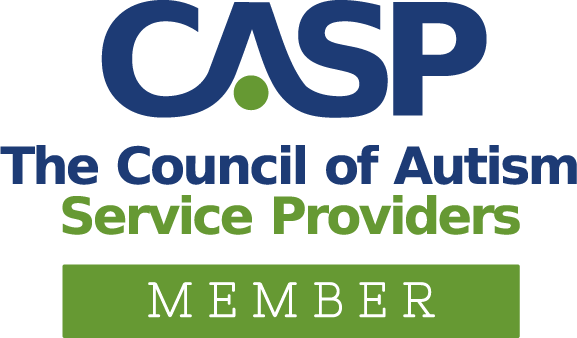Preparing for ABA-at-home therapy can benefit children with Autism Spectrum Disorder and related disorders. ABA (Applied Behavior Analysis) programs implemented in a child’s natural environment have produced better outcomes than those delivered in a clinic or school setting. However, setting up an effective ABA-at-home program can seem daunting. We’ve given you some tips on how to get started!
Our ABA specialists have decades of experience working in the field of autism with various children and families. We’ve made this list of recommendations and preliminary steps you can take to prepare your child and family for hosting regular ABA-at-home sessions. It’s important to remember that ABA takes time; in most cases, changes won’t happen overnight. Over time, your child will become more confident and comfortable during sessions, and you will start to note progress. With patience, consistency, and hard work, there will be much to gain!
Using the following eight steps, you’ll be doing everything you can to ensure your child with autism gets the most out of an ABA-at-home program.
1) Consult with ABA professionals before preparing for your ABA-at-home program.
These ABA professionals will be able to assess your child’s needs and develop a treatment plan that is tailored to their individual goals. Once you have a plan, your BCBA (Board Certified Behavior Analyst) or RBT (Registered Behavior Technician) will work with you to prepare your family for ABA-at-home sessions. This may include several preparations, such as creating a safe and nurturing environment, setting up reinforcement systems, creating a schedule, discussing outings, and developing visual support.
The BCBA and RBT working on your case may have some suggestions or special requests for things they have found effective in the past. For instance, they may ask you to cover certain toy areas with sheets or label particular bins for easier access and transparent organization. Nothing requested should be too elaborate or expensive. Try to be open-minded and ask lots of questions before making any purchases. Above all, make sure you’re comfortable with any changes or modifications.
2) Create a safe and nurturing environment for your ABA-at-Home program.
Creating a safe and nurturing space for treatment ensures that no hazards can potentially injure your child during the session. It also means providing them with a comfortable place to work on their goals. ABA sessions can be conducted anywhere in your home. Yet, having a designated space free from distractions can be most effective. This could be a quiet corner in your living room or a dedicated ABA therapy room.
If possible, select a location in your house that will be exclusively used as a “therapy space.” This not only ensures that the room won’t be used for other things, but it also helps the child get into the state of mind that when in the “therapy room,” we have fun and focus on skills. Over time the child will become used to therapy in the designated space. This technique also works to reduce problem behaviors like escaping.
Additionally, it is crucial to keep the therapy room free from as many distractions as possible. The room should be simple, serene, and in the best-case scenario, not include a TV, electronic devices, or a computer.
3) Make a list of questions you want to ask your therapist before the start of the first session.
Studies show that the effectiveness of ABA therapy for a child on the spectrum correlates with their parent’s involvement in their treatment. This is especially true related to speech, communication, and social interactions. It is essential to have an excellent line of communication between therapists and parents. It’s crucial you don’t hesitate to ask questions or voice any concerns you may have about the sessions. Everyone on the team must be on the same page.
It might also be helpful to check in with your therapist during the final five minutes of the session each day. This might be a fantastic time to ask how the session went and if there was anything they would like to share. You can also discuss what you observed or any changes you’re seeing at home.
4) Develop visual support.
Visual supports are tools that help children to understand and follow instructions. They can be used for various purposes, such as providing step-by-step instructions for completing tasks, labeling items in the environment, and helping to establish routines. Many different types of visual supports are available, so it is essential to consult with your BCBA or RBT to determine which ones will be most beneficial for your child.
In most cases, your RBT will utilize visual support during the ABA session. If your child is responsive to this approach, it may be helpful to incorporate additional visual support at home during downtime. Visual supports encourage children to try new things and help them overcome difficult transitions. Visuals also help individuals on the spectrum understand what’s coming next on their schedule. Many clients will rely on visual support to help manage their anxiety and stress levels. This can result in more appropriate behavior over time and a reduction in tantrums.
5) Establish reinforcement systems for both you and your child.
ABA therapy relies heavily on using positive reinforcement to increase desired behaviors. This means you will need a system to reward your child when they display appropriate behavior. This could include giving them verbal praise, tokens that can be exchanged for preferred activities, or small prizes. It is also essential to reinforce your own good behavior as a parent or caregiver, such as taking breaks, maintaining a positive attitude, and being consistent with the ABA program.
ABA therapy should not feel like a hassle or a chore. While some sessions will be more difficult than others, they should always feel fun. By ensuring that you and your child feel motivated and reinforced during ABA, you will likely stay consistent to reap the benefits of this effective treatment.
6) Begin implementing the ABA-at-home programs daily.
This will involve working with your child daily to help them learn new skills and reach their treatment goals. Being patient and consistent when working with your child is essential, as progress may not happen overnight. However, if you consistently stick with it, you’ll likely see excellent results!
Consistency in ABA might look a little different for everybody. For some families, it will include encouraging speech or gestures whenever the child requires access to something. It may also be consistently introducing new foods or practicing labeling things in the environment. Lastly, consistency can be practicing specific skills like waiting or cleaning up after play. The most important thing is that these skills start to become second nature for the child.
7) Invest in a child-sized table and chairs to ensure your child has a comfortable place to practice skills.
Most ABA professionals will encourage parents to purchase a child-sized table and chairs set to accommodate skill development and discrete trial teaching. It is vital to ensure that the materials you are using are age and developmentally appropriate. This will help create a more effective learning environment for your child and make it easier to work on specific skill sets.
8) Designate a specified therapy box or basket for storing tools used during ABA-at-home therapy sessions.
Items like sensory tools, reinforcers, prizes, toys, flashcards, and puzzles should only be placed aside for your ABA-at-home sessions. Your child should not be able to access these tools outside of sessions so that they remain specific to therapy and don’t become overused or exhaustive.
9) Be clear about expectations from the beginning of treatment to ensure sessions are seamless and practical.
Any rules or protocols you have in your house, like “shoes off,” should be explained to the therapist. Additionally, if certain rooms or areas of the home are off-limits for your child, make sure you communicate that from the start.
10) Discuss your child’s unique interests, favorite pastimes, and toys with their ABA professionals.
Your child’s passions and interests are essential because they can be used to motivate learning and reinforce skill development during sessions. Plus, they can help support a significant relationship between the provider and your child. By sharing information like this with your therapist, they can use it to specify activities, reward systems, and how they might outline their time.
11) Avoid interrupting or joining the ABA session without first discussing it with the ABA professional.
You should always feel free to observe therapy. Still, your therapist needs to conduct the session and handle problem behaviors as they arise. Try not to actively participate in the session without prior communication. While it may seem natural to want to help, your child needs to establish that they are working with the therapist during therapy. It also allows them to work through challenging behaviors that can be shaped later more independently.
ABA-at-Home Therapy and More at ABA Centers of America
Setting up an effective ABA program at home takes work, but it can be worth it in the long run for your child’s developmental outcomes. By following these tips, you can create a safe and nurturing environment that will support your child’s ABA therapy and help them to reach their full potential.
ABA Centers of America can provide ABA-at-home therapy as well as ABA therapy at one of our centers. Questions about how ABA-at-home can work for your family? Give us a call at 844-923-4222 or visit us at abacenters.com.







